Contact Us
RoadVision AI
Private Limited
Office No. 308 & 310, B Block
Ansal Chamber - 1, Bhikaji Cama Place,
Near Engineers India Limited (EIL) Bhawan, New Delhi - 110066
© 2024 | RoadVision AI | All rights reserved
Paver finishers are essential machines in road construction, ensuring smooth and uniform laying of asphalt or concrete. To standardize the selection, operation, and maintenance of these machines, the Indian Roads Congress (IRC) introduced the IRC:SP:86-2010 guidelines. These guidelines help road engineers and contractors choose the right paver finishers and maintain them for optimal performance and longevity.

IRC:SP:86-2010 is a comprehensive document published by the Indian Roads Congress (IRC) to provide best practices for selection, operation, and maintenance of paver finishers. It ensures that road construction projects maintain high standards of efficiency, durability, and safety.
Paver finishers are critical for the construction of roads, highways, and urban streets. They help in:
The choice of a paver finisher depends on several factors:
Paver finishers consist of two main parts:
To ensure operator and site safety, IRC:SP:86-2010 recommends:
The IRC:SP:86-2010 Guidelines for Paver Finishers play a crucial role in enhancing road construction quality, machine efficiency, and safety standards. By following these guidelines, contractors and engineers can optimize performance, extend machine lifespan, and ensure smoother road surfaces.
RoadVision AI is revolutionizing road infrastructure development and maintenance with its innovative solutions powered by computer vision AI. By leveraging advanced technologies, the platform conducts comprehensive road condition monitoring and traffic surveys, enabling early detection of surface issues like potholes and cracks for timely repairs and enhanced roads. Through traffic congestion analysis, RoadVision AI provides data-driven insights to address traffic congestion challenges and optimize road usage. With a focus on building smarter and more efficient road infrastructure, RoadVision AI ensures full compliance with IRC Codes, helping engineers and stakeholders reduce costs, minimize risks, and improve road safety and transportation efficiency.